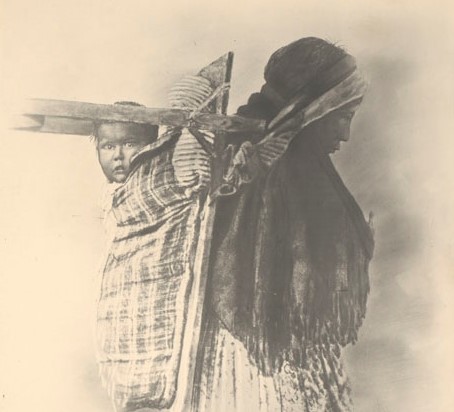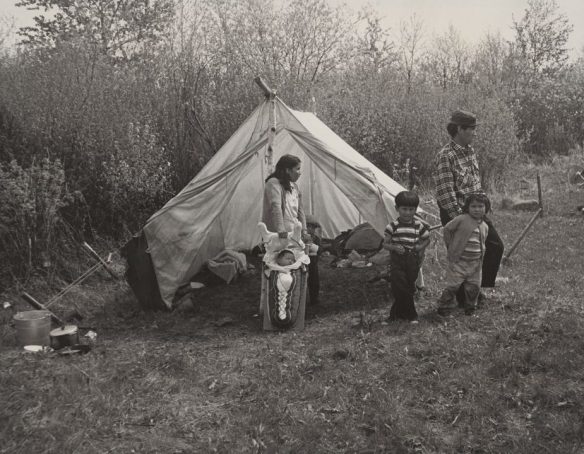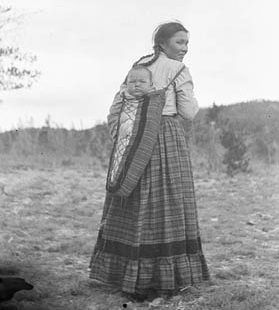This blog is part of our Nations to Nations: Indigenous Voices at Library and Archives Canada series. To read this blog post in Kanien’keha, visit the e-book.
Nations to Nations: Indigenous Voices at Library and Archives Canada is free of charge and can be downloaded from Apple Books (iBooks format) or from LAC’s website (EPUB format). An online version can be viewed on a desktop, tablet or mobile web browser without requiring a plug-in.
First Nations and Métis Nation communities used cradleboards to secure and carry infants. While the style and form varied between nations, cradleboards were typically made from thin pieces of wood to which a baby was firmly swaddled in a piece of fabric and secured with ties. Cradleboards provided parents with a safe way to carry their children during travel and allowed them use of their hands while working.

First Nation woman carrying a baby on a cradleboard with a tumpline (e011303100-006)
To learn more about images of cradleboards in the collections at Library and Archives Canada, we invite you to read Kanien’keha:ka author Elizabeth Kawenaa Montour’s blog article “First Nations cradleboards: understanding their significance and versatility” and her essay “First Nations cradleboards: an enduring heritage.”

Mary Ann Trout-Carpenter and her husband George Carpenter with their children. The baby in the cradleboard is either Melvin or Donna. James is standing behind his mother, George is in the centre, and Marianne is standing in front of her father. Lac Seul First Nation, Ontario. (e008300467)
The essay is featured in Nations to Nations: Indigenous Voices at Library and Archives Canada, a multilingual and interactive e-book. This e-book features 28 unique essays written by Elizabeth Kawenaa Montour and other First Nations, Inuit and Métis Nation staff. It is presented mostly in the Indigenous languages spoken by the people represented in each essay, and accompanied by English and French versions. The authors are Indigenous archivists, curators and advisors who have a personal connection to the collection items that they chose for their essays. Their essays show the diversity of the histories, languages and cultures of Indigenous peoples.

First Nation woman carrying a baby on a cradleboard, unknown location, 1918 (a017973)
“Cradleboard” in some Indigenous languages
-
- Anishnaabeg: tiginaaganan
- Oji-cree: tikinagan (also spelled tiginaagan, tikkanaagan or tikanagan)
- Kanien’kéha: kahrhon
- Michif: tikinagan
- Mi’kmaq: migjowajij alapilaqan
- Ojibwe: dikinaagan
- Plains Cree (nêhiyawêwin): askotaskopison
Additional resources
- Cradleboards, Library and Archives Canada’s Flickr album

![On the left, Tatânga Mânî [Chief Walking Buffalo] [George McLean] is in his traditional First Nation regalia on a horse. In the centre, Iggi and a girl engage in a “kunik,” a traditional greeting in Inuit culture. On the right, Maxime Marion, a Métis guide, holds a rifle. In the background, there is a map of Upper and Lower Canada, and text from the Red River Settlement collection.](https://thediscoverblog.files.wordpress.com/2022/09/image-1.jpg?w=584&h=365)